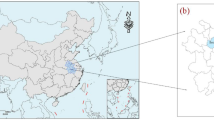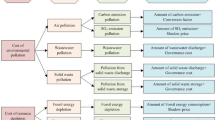Abstract
The German industry originates and uses the concept of industry 4.0 for the effective production. In today’s scenario, the technologies like the Internet of Things (IoT), cyber-physical systems and the emergence of industries have negative impact on environmental sustainability. While continuing to further economic growth, China provokes the dual experiment of reducing utilization of energy. The types of technological and financial opportunities are affected by the improvement in economic growth. In order to deal with the increasingly prominent energy constraints and increasingly serious problems in the economic and social development, this paper uses the grey theory which can contract with the little information and uncertainty in the system, and establishes the GM (1, 1) prediction model for carbon emissions prediction and the added value of various industries in China. All the experiments are done by using MATLAB. It is observed from the results that the carbon emissions under LC and ELC scenarios will decrease by 18.87% and 36.82% respectively as compared with Bau scenario. The conclusion confirmations that the carbon emissions of various industries in China are on the rise, and the carbon emissions will be greatly reduced by 2030.






Similar content being viewed by others
References
Abbasi A, Javed AR, Chakraborty C, Nebhen J, Zehra W, Jalil Z (2021) ElStream: an ensemble learning approach for concept drift detection in dynamic social big data stream learning. IEEE Access 9:66408–66419
Alam J (2014) On the relationship between economic growth and CO2 emissions: the Bangladesh experience. IOSR J Econ Fin (IOSR-JEF) 5(6):36–41
Anwar A, Younis M, Ullah I (2020) Impact of urbanization and economic growth on CO2 emission: a case of far east Asian countries. Int J Environ Res Public Health 17(7):2531
Aye GC, Edoja PE (2017) Effect of economic growth on CO2 emission in developing countries: evidence from a dynamic panel threshold model. Cogent Econ Fin 5(1):1379239
Carayannis EG, Campbell DF (2010) Triple Helix, Quadruple Helix and Quintuple Helix and how do knowledge, innovation and the environment relate to each other?: a proposed framework for a trans-disciplinary analysis of sustainable development and social ecology. Int J Soc Ecol Sustain Dev (IJSESD) 1(1):41–69
Chakraborty C (2021) Data-driven mining, learning and analytics for secured smart cities: trends and advances. Springer, New York
Chakraborty C, Roy S, Sharma S, Tran TA (2020) Environmental sustainability for green societies–the impact of the COVID-19 Pandemic
Chen S, Shi A, Wang X (2020) Carbon emission curbing effects and influencing mechanisms of China’s emission trading scheme: the mediating roles of technique effect, composition effect and allocation effect. J Clean Prod 264:121700
Dey N, Hassanien AE, Bhatt C, Ashour A, Satapathy SC (eds) (2018) Internet of things and big data analytics toward next-generation intelligence (Vol. 35). Springer, Berlin
Guo J, Zhou Y (2020) Transformation of heavy metals and dewaterability of waste activated sludge during the conditioning by Fe2+-activated peroxymonosulfate oxidation combined with rice straw biochar as skeleton builder. Chemosphere 238:124628
Guo J, Jiang S, Pang Y (2019) Rice straw biochar modified by aluminum chloride enhances the dewatering of the sludge from municipal sewage treatment plant. Sci Total Environ 654:338–344
Jagota V, Sethi APS, Kumar K (2013) Finite element method: an overview. Walailak J Sci Technol 10(1):1–8
Jairath K, Singh N, Jagota V, Shabaz M (2021) Compact Ultrawide band metamaterial-inspired split ring resonator structure loaded band notched antenna. Math Probl Eng. https://doi.org/10.1155/2021/5174455
Jia N, Gao X, Liu D, Shi J, Jiang M (2019) Identification and evolution of critical betweenness sectors and transactions from the view of CO2 reduction in supply chain network. J Clean Prod 232:163–173
Jian J, Fan X, He P, Xiong H, Shen H (2019) The effects of energy consumption, economic growth and financial development on CO2 emissions in China: a VECM approach. Sustainability 11(18):4850
Kaur M, Khan MZ, Gupta S, Noorwali A, Chakraborty C, Pani SK (2021) MBCP: performance analysis of large scale mainstream blockchain consensus protocols. IEEE Access
Khan MK, Khan MI, Rehan M (2020) The relationship between energy consumption, economic growth and carbon dioxide emissions in Pakistan. Fin Innov 6(1):1–13
Kishor A, Chakraborty C, Jeberson W (2021) Intelligent healthcare data segregation using fog computing with internet of things and machine learning. Int J Eng Syst Model Simul 12(2–3):188–194
Kumar A, Jagota V, Shawl RQ, Sharma V, Sargam K, Shabaz M, Khan MT, Rabani B, Gandhi S (2021) Wire EDM process parameter optimization for D2 steel. Mater Today Proc 37(2):2478–2482
Li F, Zhang J, Liu W, Liu J, Huang J, Zeng G (2018) An exploration of an integrated stochastic-fuzzy pollution assessment for heavy metals in urban topsoil based on metal enrichment and bioaccessibility. Sci Total Environ 644:649–660
Li W, Yang G, Li X, Sun T, Wang J (2019) Cluster analysis of the relationship between carbon dioxide emissions and economic growth. J Clean Prod 225:459–471
Liang W, Fan Y, Li KC, Zhang D, Gaudiot JL (2020) Secure data storage and recovery in industrial blockchain network environments. IEEE Trans Industr Inf 16(10):6543–6552
Liu L, Chen C, Zhao Y, Zhao E (2015) China's carbon-emissions trading: overview, challenges and future. Renew Sustain Energy Rev 49:254–266
Manta AG, Florea NM, Bădîrcea RM, Popescu J, Cîrciumaru D, Doran MD (2020) The nexus between carbon emissions, energy use, economic growth and financial development: evidence from central and eastern European Countries. Sustainability 12(18):7747
Meghanathan N, Nagamalai D, Chaki N (2012) Advances in computing and information technology. In: Proceedings of the second international conference on advances in computing and information technology (ACITY)
Oláh J, Aburumman N, Popp J, Khan MA, Haddad H, Kitukutha N (2020) Impact of industry 4.0 on environmental sustainability. Sustainability 12(11):4674
Rakhra M, Singh R, Lohani TK, Shabaz M (2021) Metaheuristic and machine learning-based smart engine for renting and sharing of agriculture equipment. Math Probl Eng. https://doi.org/10.1155/2021/5561065
Rupani PF, Nilashi M, Abumalloh RA, Asadi S, Samad S, Wang S (2020) Coronavirus pandemic (COVID-19) and its natural environmental impacts. Int J Environ Sci Technol 17(11):4655–4666
Saidi K, Hammami S (2015) The impact of CO2 emissions and economic growth on energy consumption in 58 countries. Energy Rep 1:62–70
Salahuddin M, Khan S (2013) Empirical link between economic growth, energy consumption and CO 2 emission in Australia. The J Dev Areas 81–92
Shaari MS, Rahim HA, Rashid IMA (2013) Relationship among population, energy consumption and economic growth in Malaysia. Int J Soc Sci, 13(1)
Taylor PJ, Dargahi T, Dehghantanha A, Parizi RM, Choo KKR (2020) A systematic literature review of blockchain cyber security. Digit Commun Netw 6(2):147–156
Tong T, Ortiz J, Xu C, Li F (2020) Economic growth, energy consumption, and carbon dioxide emissions in the E7 countries: a bootstrap ARDL bound test. Energy Sustain Soc 10:1–17
Wang K, Yu J, Yu Y, Qian Y, Zeng D, Guo S, Wu J (2017) A survey on energy internet: architecture, approach, and emerging technologies. IEEE Syst J 12(3):2403–2416
Wang B, Yao X, Jiang Y, Sun C, Shabaz M (2021) Design of a real-time monitoring system for smoke and dust in thermal power plants based on improved genetic algorithm. J Healthcare Eng. https://doi.org/10.1155/2021/7212567
Xiao Y, Bhola J (2021) Design and optimization of prefabricated building system based on BIM technology. Int J Syst Assur Eng Manag. https://doi.org/10.1007/s13198-021-01288-4
Yuan R, Zhao T (2016) A combined input–output and sensitivity analysis of CO2 emissions in the high energy-consuming industries: a case study of China. Atmos Pollut Res 7(2):315–325
Zeng J, Liu T, Feiock R, Li F (2019) The impacts of China’s provincial energy policies on major air pollutants: a spatial econometric analysis. Energy Policy 132:392–403
Zhang XP, Cheng XM (2009) Energy consumption, carbon emissions, and economic growth in China. Ecol Econ 68(10):2706–2712
Zhang W, Li J, Li G, Guo S (2020) Emission reduction effect and carbon market efficiency of carbon emissions trading policy in China. Energy 196:117117
Funding
None.
Author information
Authors and Affiliations
Corresponding author
Ethics declarations
Conflict of interest
The author(s) declare(s) that there is no conflict of interest regarding the publication of this paper.
Human and animal participants
This research do not involve Human or Animal participants for any kind of testing on them.
Additional information
Publisher's Note
Springer Nature remains neutral with regard to jurisdictional claims in published maps and institutional affiliations.
Rights and permissions
About this article
Cite this article
Jiang, L., Sakhare, S.R. & Kaur, M. Impact of industrial 4.0 on environment along with correlation between economic growth and carbon emissions. Int J Syst Assur Eng Manag 13 (Suppl 1), 415–423 (2022). https://doi.org/10.1007/s13198-021-01456-6
Received:
Revised:
Accepted:
Published:
Issue Date:
DOI: https://doi.org/10.1007/s13198-021-01456-6




